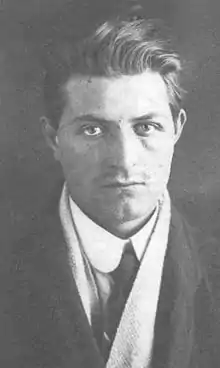| Part of a series on |
| Anarchism |
|---|
 |
| Part of a series on |
| Libertarianism |
|---|
Expropriative anarchism (Spanish: anarquismo expropiador) is the name given to a practice carried out by certain anarchist affinity groups in Argentina and Spain which involved theft, robbery, scams and counterfeiting currency.[1][2][3] The robberies done were called "expropriations on the bourgeoisie". It had its major peak between 1920 and 1935 and some of its most famous practitioners were Buenaventura Durruti, Francisco Ascaso, Severino Di Giovanni, Miguel Arcángel Roscigna, and Lucio Urtubia. It was different from French illegalism because it was not thought of as a way of life but as a way of reaching political ends such as financing revolutionary activities, anarchist propaganda and the release of anarchist prisoners.[4]
Examples
Miguel Arcángel Roscigna and Andrés Vázquez Paredes, who had collaborated with Buenaventura Durruti and Los Solidarios when they were in Argentina, later executed a series of bombings against United States interests in response to the execution of Sacco and Vanzetti. In this campaign, the notorious Italian expropriator Severino Di Giovanni joined in. Roscigna y Vázquez Paredes alongside Antonio Moretti and Vicente Moretti carried out a robbery on the Rawson Hospital of Buenos Aires in October, 1927, where they obtained the amount of 141.000 pesos. According to historian Oswaldo Bayer, Roscigna, with this money they financed the counterfeiting of Argentinian currency.[3]
The Moretti brothers and three Catalans recommended by Durruti decided to rob the Cambio Messina in Montevideo, with an outcome of 3 deaths and only 4000 pesos. They ended up being arrested but shortly put in practice a spectacular jailbreak. Di Giovanni started publishing a magazine called Culmine and anarchist propaganda, all of which was financed partly by robberies.[5] The anarcho-syndicalist publication La Protesta started criticizing Di Giovanni and his group in strong terms, even going so far as accusing him of being a spy and a police agent. Rosigna continued the expropriations but with the purpose of aiding anarchist prisoners.[6]
Groups such as Rewolucyjni Mściciele (Revolutionary Avengers) and Chernoe Znamia (The Black Banner), active at the beginning of the 20th century, used expropriation as a means to fund their activities.[7]
References
- ↑ El anarquismo expropiador El uso de la violencia en beneficio de la Idea by Federico Millenaar
- ↑ Anarquismo expropiador en río de la Plata Published by Barricada,from Montevideo
- 1 2 Osvaldo Bayer, Los anarquistas expropiadores y otros ensayos. Booklet, Buenos Aires, 2008, p. 65.
- ↑ "Se puede ver desde los testimonios de la época que, el accionar de los anarquistas y siguiendo la lógica de sus protagonistas, que la expropiación tenía claramente fines políticos. Existen testimonios de expropiadores y allegados a estos en donde se deja en claro que las condiciones de vida de estos no modificaron luego de las expropiaciones. No se enriquecieron en pocas palabras. Tampoco fue el caso de los grupos que posteriormente, y en otra coyuntura, se abocaron a esta tarea." Anarquismo expropiador en río de la Plata Published by Barricada, from Montevideo
- ↑ Anarquismo en la Argentina Di Giovanni, el expropiador by Federico Millenaar
- ↑ Osvaldo Bayer, Los anarquistas expropiadores y otros ensayos. Booklet, Buenos Aires, 2008, p. 69.
- ↑ Sekura, Adrian (2010). Rewolucyjni Mściciele śmierć z browningiem w ręku. Poznań: Bractwo Trojka. ISBN 9788392666264.
Bibliography
- Bayer, Osvaldo. Severino Di Giovanni, el idealista de la violencia. Booket, Buenos Aires, mayo de 2006. ISBN 9875800929
- Bayer Osvaldo, Los anarquistas expropiadores y otros ensayos. Booket, Buenos Aires, 2008.
- Bayer, Osvaldo. Severino Di Giovanni, el idealista de la violencia. Buenos Aires: Galerna, 1970.
- Noble, Cristina. Severino Di Giovanni, Pasión Anarquista. Buenos Aires: Ed. Capital Intellectual, 2006.

